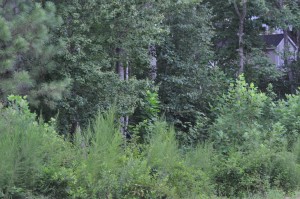KN, p. 178 “Is the builder dead yet?”
“What? Is somebody trying to kill the builder?” you ask.
‘They’ might be thinking about it. As in, more than one person is annoyed.
Here’s what is happening. When we moved in, the neighborhood was full of wooded lots. Even the properties with houses already there, had plenty of trees at the edges, along the fences, or next to the houses. Some were mature trees that had been left on the otherwise cleared lots before construction had begun. Property owners added flowering trees as time passed. Wildlife flourishes in this residential neighborhood of 1/4 and 1/3 acre lots. We’re not out in the country, but these are not zero-lot homes either.
Phases 1 and 2 of the larger housing development have long been completed. Phase 3 was finished three years ago, the original trees are beautiful, and the owners are adding new fruit/flowering trees each year.
Enter Phase 4. The original developer had a few lots left and found a builder to buy them. That builder wanted the lots cleared before finalizing the deal. That’s when we, the neighbors, discovered that some of the grassy/lightly-wooded areas between existing homes were actually unsold lots.
ALL of the trees from those lots are being cleared, lots of red dirt remains, and now mudslides into neighboring backyards are expected with the next heavy rain.
The developer in charge of the work told me on the phone that the lots are not wide enough to have left the trees in place. The one in the photos is 60 feet wide. Years ago, I lived in a house surrounded by maples and evergreens. That lot was 50×100. IMO, this guy simply did not want to take the time to leave a couple of trees to shade the house and protect the wildlife on the lot.
The neighbors to the left and right of the bulldozer photo were concerned enough to have the City Inspector come out to assess the situation. Note the dirt to the left appears to be in a pile that crosses the property line and would be the most likely to slide into the neighbor’s yard in the rain.
The builder’s solution was to place sand barrier ‘fencing’ on the property line. The bulldozer operator moved the dirt up against it.
Other lots have similar problems with soil grading and tree removal.
Heated conversations have been held. The neighborhood grapevine is operating at peak efficiency. Town council meetings are scheduled on the topic.
In case you doubt that neighbors and builders would actually get angry over something like this, read on.
Existing homeowners in Colorado were upset with new builders in the neighborhood who appeared to be putting in homes that did not conform to the look of the development, thereby lowering everyone’s property values. Building was delayed while plans were reviewed. Board members who were in charge of approving the designs (but didn’t) were removed from their positions and new people replaced them.
http://www.reporterherald.com/ci_20492538/homeowners-builder-bank-at-odds-lovelands-taft-farms
When developers with big money at stake and disgruntled homeowners with possible deflated property values are at odds, tempers can flare, injunctions can occur, and nothing good happens. If the builder complies with city ordinances, there is little recourse for the neighbors who don’t care for the look of the newer houses, or how the new homes will affect them.
City codes exist for a reason. Check yours out. You might be surprised at what is NOT included in some communities, such as: building setbacks, curbing pets, rules about garbage, home swimming pool regulations, livestock allowed in the city limits, etc.
We haven’t seen any bodies in the remaining woods yet, but it is still early in the process. Kidding. Tempers are high, but so far, everybody is at the yelling stage. Let’s hope that reason prevails and the builder corrects the problems he has created, and doesn’t produce any new ones.
2020 Update:
The two houses built on the properties in the photos have flooding issues. One has a perpetual pond in the backyard from the water cascading down the slope, requiring special drains to keep the water away from the house. The builder was within city code requirements and took no responsibility for the flooding caused by his bulldozing method. Buyer beware.
*Photos by Patti Phillips
KN, p. 178 “Is the builder dead yet?” Read More »











